
|
A pioneer settlement near a stagecoach stop on Cummins Creek — some 80 miles northwest of Houston — acquired the name “Round Top” in the 1840’s from the octagonal roof of a house on a hill, from which the settlers watched for both the approaching stagecoach and hostile Indians. The first Europeans had arrived in the area in the 1830’s and established cotton plantations on the Spanish land grants they had received. Many of these early settlers fought alongside Sam Houston in the Texas “War of Independence” from Mexico.
In 1843 a German nobleman, Count Boos-Waldeck, purchased the 4,000-acre Nassau Plantation near Round Top for the Adelsverein, an organization that promoted German immigration to Texas. Although the Verein decided not to place its colonists on Nassau Farm, fearing they might lose their cultural identity if they lived too close to existing American settlements, other German immigrants began to buy land in the area. By 1850, Round Top had a population of 150, a blacksmith shop, saddle shop, doctor, general merchandise store, cigar factory, and livery stable. By the time the Wiederaenders family arrived in Round Top in 1854, the German presence was significant. One of the early Germans immigrants was Carl Siegismund Bauer, a stonemason from Annaberg who was a contemporary of Carl Gottlob Wiederaenders. Bauer immigrated in 1848 with 12 family members, including his wife, grown daughters and sons, and several grandchildren — just as Carl Gottlob was beginning to plan for his own family’s emigration. The example and presence of their Annaberg compatriots may well have influenced the Wiederaenders’ decision to settle in Round Top. The Bauers were probably the “friends” with whom Eleonore Wiederaenders stayed after the death of her husband. It is even possible that Edward was learning stonemasonry from Carl Bauer at the time he was drafted into the Civil War — his occupation is listed as “stonemason” on his induction record. Bauer’s daughter-in-law, Wilhelmine Siedentopf, delighted in the opportunities her new country afforded. She wrote back to Germany in 1854: I like it here because better prices are paid for sewing than in Germany. I like the glorious freedom, the small payments to the owner, no class distinction, and the fact that if a person’s conduct is good, even though he is poor, he is respected just as much as the person who is worth thousands. But the new immigrants suffered from the hot, humid summers and their accompanying afflictions. Carl Bauer’s grandson later wrote: 1849 was an unusually wet year. It rained so much that it brought on a very unhealthful condition. The mosquitoes came in such droves that at night we could sleep only by keeping cover over us even during the hot summer time. One after another we were down with malaria, spending more time in bed than working. My father had a siege of 18 months; we others from four to six months. Weakened by malaria and yellow fever, many immigrants died from these or other ailments (including Anton and Ernst Wiederaenders — both in the prime of their lives). Those who survived turned their energy to farming and craftsmanship, and generally prospered. By 1860, German settlers owned 129 farms in Round Top. Cotton was the predominant crop, while corn, hay, and produce were also grown. The German pioneers were admired by one Fayette County historian for their propensity to work hard and play well: The German farmer is thorough and industrious. He takes pride in keeping his farm land in the best condition. If possible he buys out the land of his American neighbor. The Round Top and Rutersville settlements offer good illustrations of this tendency, for here the original American owners have nearly all gone and the descendants of the acquisitive German pioneers are in full control of the land. The German has shown his busy American neighbor, who took even his pleasure seriously, how to relax after toil. The German philosophy of life as expressed in a German student song — “Wer nicht liebt Wein, Weib und Gesang/Der bleibt ein Narr sein Lebenlang”(He who does not love wine, women and song/Remains a fool his whole life long) — was put into practice wherever the Germans settled....Special seasons, such as Easter, Christmas, and Pentecost, were the occasions for merrymaking and prolonged holidays. The German brought...the European Sabbath much to the despair of his American neighbor who held rigorously to the Puritan Sunday, but could not keep his children from making merry with the Germans on Sunday. Family events such as birthdays, christenings, “Verlobung” (engagements), and marriages provided the opportunity for lusty gatherings which lasted far into the night. The Germans of Fayette County helped to bring the music of their “Vaterland” to Texas. As early as 1848 a band of German musicians were furnishing music for public occasions....These pioneer musicians held weekly band practice under the most difficult circumstances. During the day they followed the plow and at night they often rode from 15 to 20 miles to band practice. When the band played for dances the hours were from sunset to sunrise. When a “Fest” (celebration) was held, they played from ten in the morning until sunrise the next morning. [Note: At which point the partygoers went straight to the fields for a full day’s work.] “American” and German settlers regarded each other warily: The relationship of the American and German pioneer in Fayette County was marked by a patronizing attitude on the part of the American and an aloofness on the part of the German who asked nothing of his neighbor except to be left alone in order that he might acquire economic independence and preserve the language and customs of the Fatherland.... The German peasant lacked the polish of the American as well as his charm of manner. The American, on the other hand, lacked some of the fundamental virtues which made the German a decided economic asset to the community in which he settled. The church provided an essential anchor for the community of German transplants. The first Lutheran missionaries and pastors arrived in the county in the 1850’s, establishing a small congregation, St. John’s Lutheran Church, three miles from Round Top in 1856. There Edward Wiederaenders was confirmed and his brother Gustav was married. |
Click on pictures to enlarge
 A log cabin dating from the earliest days of Fayette County 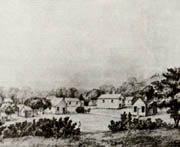 Round Top, Texas 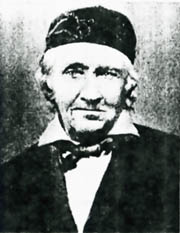 Carl Siegismund Bauer 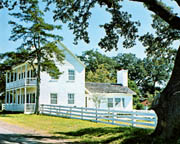 The stone house Carl Bauer built for his daughter in 1852, a replica of his home in Saxony 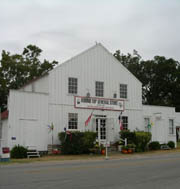 The Round Top General Store, built in 1847 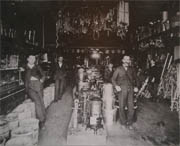 The interior of the General Store in nearby Serbin, Texas 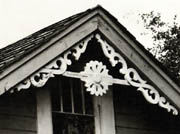 A German architectural detail from Round Top 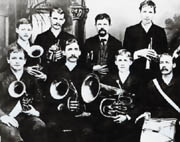 A German band 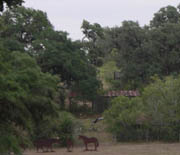 A farm in Round Top 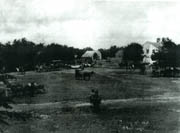 Independence Day parade in Round Top |
|||
|
Early in 1861, a young missionary named Adam Neuthard arrived from Germany to take over Round Top’s several small congregations. Born a Roman Catholic and raised to be a priest, Neuthard had embraced Protestantism while attending Heidelberg University and went on to seminary at St. Chrischona, Switzerland (his parents disowned him for this). He was brilliant, energetic, and highly educated. His gifted oratory soon drew large numbers of people from all over the county to his sermons. A dedicated teacher, he ran the school at St. John’s before building a larger school in Round Top. During his first months in Texas, Neuthard inspired both Emil and Edward Wiederaenders to study theology with him. He put the brothers to work as teachers in the small church schools he was fostering.
In February 1861, the Civil War came to Texas. (Fayette County was one of the few counties in the state to vote against secession.) Round Top served as a Confederate army recruiting station for the northern half of the county. Although the German immigrants opposed slavery, they marched dutifully off to war. The war years brought hardship and privation to soldiers and civilians alike. Basic necessities like food, fuel, and transportation were scarce. All able-bodied men had been drafted into the army. But Round Top’s greatest period of unrest came after the war. First the Yankees came through looting; they were followed by the “rowdies,” diehard renegades who terrorized the countryside until the town incorporated in 1870 and re-established law and order. The war had forced Adam Neuthard to abandon his plans for a seminary and turn his full attention to providing more basic education, while ministering to a population under duress. He organized and preached to small groups of settlers in the surrounding areas regardless of their religious affiliation. (This independence of spirit drew criticism from more orthodox Lutheran clergy.) In 1862 Neuthard married Emma Rummel, a granddaughter of Carl S. Bauer. As soon as the war was over and the soldiers who had been spared returned, Neuthard began building a large two-story home and boarding school. Upon its completion in early 1866, the cornerstone was laid for a new church. Carl Siegismund Bauer was the guiding spirit behind the construction of both of these imposing stone buildings. His sons and grandsons, as well as many other German settlers, quarried the limestone, hewed and milled the local cedar trees, and lent their craftsmen’s skills to help provide for the education and spiritual needs of the community. Bethlehem Lutheran Church was completed in five months. On January 13, 1867, 135 founding members signed its constitution, among them one “Eduard Wiederaenders.” That same year, the congregation sent its mission festival offerings to “Mr. Emil Wiederaenders at Wartburg, Iowa” — the congregation’s first son to enter the ministry. Rev. Neuthard taught all the students in the surrounding area — up to 97 at a time — as there were no other schools. His house was soon crowded with the 20 students who boarded there (at $5 per month) in addition to the day pupils. Their course of study included geography, history, grammar, arithmetic, geometry, algebra, German, French, Latin, penmanship, and vocal training. He also held summer sessions, as well as night classes for adults who wanted to improve their knowledge or learn English. By the time his school became part of the public school system in 1878, more than 2,000 students had attended it. With the end of slavery, the original American plantation owners in the area began to move away, and the land was divided and sold to German Texans — which eventually meant that the German culture and language became dominant in the area. In subsequent decades, Round Top prospered as a small farming and mercantile community. Today, two of Carl Bauer’s stone landmarks still grace the town, along with several old wooden buildings from pioneer times. Round Top is well known for its spring and autumn antique fairs and the International Festival Institute for the performing arts. Although Eleonore Wiederaenders and her sons Edward and Emil left for Wisconsin in 1869, Carl Gottlob’s eldest son Gottlob remained in nearby Serbin, where he farmed and raised a large family. Gottlob’s son Edward George married a granddaughter of Carl Siegismund Bauer and settled in Round Top. Their son Arthur became a minister and professor at Texas Lutheran University. He is one of 23 known Lutheran ministers numbered among the direct descendants of the elder Carl Gottlob Wiederaenders (as of 1967), in addition to 14 ministers’ wives. © Julia Moore, 2007. All rights reserved. Sources: Weyand, Leonie Rummel, and Wade, Houston, Early History of Fayette County, La Grange Journal, 1936. “Early Life in Texas,” from the diary of Carl William Rummel, as translated by Lena Rummel Dornberger. Obst, Martin, and Banik, J. G., Our God is Marching On, Bethlehem Lutheran Church, Round Top, 1966. |
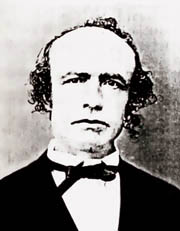 Reverend Adam Neuthard 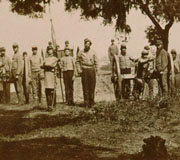 Confederate soldiers wih artillery 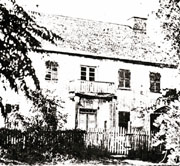 The Neuthard home and school 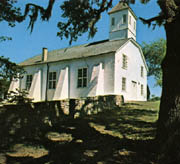 Bethlehem Lutheran Church 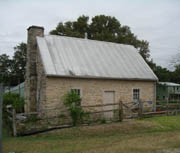 The workshop of Traugott Wantke, organ builder 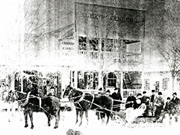 19th century Round Top after a rare snowfall 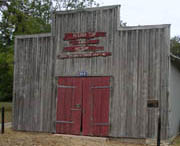 Round Top Area Historical Society building |